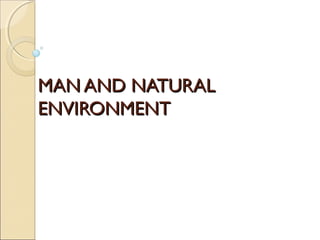
Man & natural environment
- 1. MAN AND NATURALMAN AND NATURAL ENVIRONMENTENVIRONMENT
- 2. INTRODUCTIONINTRODUCTION Environment means the surrounding conditions that effects the lifestyle of living things. It includes biotic and abiotic components. Our surroundings includes natural and manmade things. Human life gets affected by the environment and hence we find differences in the human life of different regions.
- 3. Natural environmentNatural environment All components which come into existence naturally are included in natural environment. The landforms on the earth, the climate, soils, minerals, sunlight etc are components of our natural environment.
- 5. CULTURAL ENVIRONMENTCULTURAL ENVIRONMENT In order to enrich his life man has used many natural resources and in this process he has brought many changes in natural environment. Human settlements, roads, buildings, dams etc have developed through this.
- 7. Interactions in environmentInteractions in environment THERE ARE MANY INTERACTIONS BETWEEN BIOTIC [LIVING] AND ABIOTIC [NON LIVING] COMPONENTS. ALL THE BIOTIC COMPONENTS DEPEND ON EACH OTHER.WE BREATHE AIR THAT MEANS THERE IS AN INTERACTION BETWEEN US[LIVING] AND THE AIR [NON LIVING] PLANTS MAKE PRODUCE THEIR FOOD USING SOLAR ENERGY.THAT MEANS THERE IS AN INTERACTION BETWEEN ABIOTIC AND BIOTIC COMPONENTS.
- 8. PLANT DURING PHOTOSYNTHESISPLANT DURING PHOTOSYNTHESIS
- 9. ECOLOGYECOLOGY A BRANCH OF BIO-SCIENCES THAT STUDIES THE INTERDEPENDENCE,INTERRELATIONSAND INTERACTIONS OD BIO-COMMUNITY WITH ITS ENVIRONMENT. THE CHANGES OCCURING IN THE ENVIRONMENT AND THEIR EFFECTS ON THE LIVING WORLD ALSO FORM AN IMPORTANT OF THE SUBJECT MATTER OF ECOLOGY.
- 10. ECOSYSTEMECOSYSTEM A closely related group bio-community and the surrounding environment. On which the life of the community depends together form an eco- system together form an eco-system. All the natural regions wherein interactions takes place between abiotic and biotic components are callecd ec o EG: ACQUATIC ECOSYSTEM,FOREST ECOSYSTEM,LAKE ECOSYSTEM,MEADOW ECOSYSTEM.
- 12. AUTOTROPH HETEROTROPHAUTOTROPH HETEROTROPH ABIOTIC COMPONENTS BIOTIC COMPONENTS A T SUN M O WATER S P CARBON-DI- OXIDE H E LAND/SOIL R E PRIMARY CONSUMERS Producer Secondary consumers Tertiary consumers Decomposer
- 13. ◦ THE BIOTIC COMPONENTS IN AN ECOSYSTEM IS CLASSIFIED AS PRODUCERS,CONSUMERS AND DECOMPOSERS.THE CONSUMERS ARE FURTHER DIVIDED INTO PRIMARY,SECONDARY AND TERTIARY CONSUMERS
- 14. FUNTION OF AN ECOSYSTEMFUNTION OF AN ECOSYSTEM The sun is the main source of energy Green plants produce food with the help of solar energy trough the process of photosynthesis. Hence they are called PRODUCERS. Plants utilize their own food and they produce their own growth. The rest they store in the form of energy plants are used by herbivorous animals as food.
- 16. PRIMARY CONSUMER.. The plants are the producers whereas the hair that uses only green plants as its food is called primary consumer… SECONDARY CONSUMER… The hare becomes food for a snake hence carnivores animals like snakes are called secondary consumers… TERTIARY CONSUMERS….. The snake becomes food for an eagle hence eagle is called tertiary consumer. Eagle is in highest consumer in the food chain……..
- 17. The energy in the form of food enters the body of carnivorous and omnivorous and is used for their physiological functions. This is how the energy cycle work Herbivorous become food of carnivorous and omnivorous like man.
- 18. Worms ,Fungi, Insect Etc Decomposer .The Remain Of Dead Animals And Plants. Hence they convert organic matter into organic matter. The matter get mixed in soil............
- 20. ENERGY TRANSFERENERGY TRANSFER WITH THE HELP OF SOLAR ENERGY; PLANTS PRODUCE FOOD. FOOD IS ENERGY. THIS ENERGY GETS TRANSFERRED TO PRIMARY, SECONDARYAND TERTIARY CONSUMERS TO DECOMPOSERS.THIS COMPLETESTHE ENERGY CYCLE. THE SEQUENTIAL TRANSFER OF ENERGY IN THE FORM OF FOODIS CALLED FOOD CHAIN. LEVELS OF FOOD TRANSFER ARE CALLED FOOD CHAIN.
- 21. FOOD WEBFOOD WEB A CONSUMER CAN OBTAIN HIS FOOD IN DIFFERENT WAYS. AS A RESULT,MULTIPLE FOOD CHAINS COME INTO EXISTENCE IN AN ECOSYSTEM. DIFFERENT FOOD CHAINS GET CONNECTED TO FOOD WEB.
- 22. SOIL FOOD WEBSOIL FOOD WEB
- 23. FOOD PYRAMIDFOOD PYRAMID SOME OF THE ENERGY GETS LOST AT EACH LEVEL. DUE TO THIS WHILE MOVING FROM PRODUCERS TO LOSS DIFFERENT TYPES OF CONSUMERS,THERE IS A DECREASE IN ENERGY. IF ONE ATTEMTS DIAGRAMMATIC REPRESENTATION OF THIS PROCESS THIS DIAGRAM APPEARS LIKE A PYRAMID.THIS IS CALLED FOOD CHAIN.
- 25. ENVIRONMENTAL BALANCEENVIRONMENTAL BALANCE IF THE NUMBER OF BIOMASS AND ORGANISM IS IN PROPER PROPORTION AT DIFFERENT TROPHIC LEVELS,THE ENVIRONMENT OF THAT REGION IS SAID TO BE BALANCED. MAN HAS CLEARED THOUSAND HECTARES OF FOREST LANDS FOR HIS DEVELOPMENT AS A RESULT THE ENVIRONMENTAL BALANCE IS SAID TO BE DISTURBED. MAN IS INTELLIGENT THAN OTHER ORGANISM.THEREFORE IT IS HIS DUTY TO PROTECT THE ENVIRONMENT
- 26. MAN CUTTING TREESMAN CUTTING TREES
